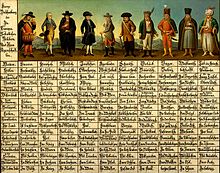National character

As national character mapping is stereotypes about nations understood that for a basis for prejudice or discrimination may represent, and secondly the foundation of identities serve. From a social-psychological perspective, these national stereotypes serve to simplify the characterization of groups of people, which, with the division of the world into a limited number of distinguishable “ peoples ” and “nations”, helps to simplify the complexity of the linguistic and cultural heterogeneity of the world. In addition to their individual psychological function, national stereotypes in the sense of a national character are components of collectively shared knowledge and materialize themselves supra-individually and intersubketively in different linguistic and visual products. National characters or their constellation and effect are researched primarily by cultural sociology and folklore .
Historically, the concept of a national character developed from protoscientific ideas such as those shown in the depictions of peoples in the 17th and 18th centuries. One example is the graphic Lamentable Discurs of Different Nations , which shows a German, a Milanese, a Neapolitan and a Sicilian in "nationally typical" clothing discussing the consequences of the War of the Polish Succession . The psychological and cultural characteristics shown to differentiate between the “peoples” were theoretically justified with the theory of temperament , on which the climate theory was ultimately based with its idea of the connection between climatic conditions and psychological and moral characteristics. These ideas were found, for example, in the copper engraving Aigentliche Presentation and Description of the Leaders in Europe , the so-called Leopold engraving, which was created in Augsburg between 1719 and 1726, or the painting Kurtze Description of the Peoples in Europe and their properties , which was made between 1730 and 1740 in Styria, expression. The comparison of the European peoples on the basis of a grid of typical characteristics corresponded to the classifying approach of natural history in the 18th century. This methodological approach lost its legitimation in the course of the 19th century, but lived on in the attribution of stereotypes. With the beginning of modernity , the identity-enhancing function of such stereotypes came to the fore.
The use of the concept of national character in the social sciences set itself apart from protoscientific ideas . In the Second World War, national character research was used for psychological warfare and was used in the intelligence context. Although the national character receded in the social sciences from the middle of the 20th century, attempts continued to be made to use it as a theoretical concept for recording culture-specific differences between nationally defined groups. In the mid-1990s , for example, the Polish sociologist Edmund Lewandowski referred to the national character as “the ensemble of attitudes and behavior patterns common to the majority of a society, historically shaped and preserved from generation to generation”.
literature
- Gianenrico Bernasconi, Julia Dilger, Carsten Lohmann (Eds.), Pictures in our head. Images of others and oneself in Europe (writings of the Museum of European Cultures, Issue 9), Berlin 2010, ISBN 978-3-8860-9676-3 .
- Gianenrico Bernasconi, National Stereotypes and Intercultural Communication , in: Elisabeth Tietmeyer and Irene Ziehe (Eds.), Kulturkontakte. Life in Europe , Koehler & Amelang, Leipzig 2011, ISBN 978-3-7338-0382-7 , pp. 72–79.
- Franz M. Eybl, type, temperament, table. On the anthropological and media-theoretical systematics of ethnic stereotypes , in: Mirosława Czarnecka, Thomas Borgstedt, Thomasz Jabłecki (eds.), Early modern stereotypes. On the productivity and restrictiveness of social patterns of imagination (Yearbook for International German Studies, Series A, Volume 99), Bern a. a. 2010, ISBN 978-3-0343-0329-3 , pp. 29-43.
- Hans Henning Hahn (Ed.), Historical Stereotype Research. Methodical considerations and empirical findings , Oldenburg 1995, ISBN 3-8142-0506-5 .
- Silke Meyer, The Iconography of the Nation. National stereotypes in English prints of the 18th century , Münster a. a. 2003, ISBN 3-8309-1303-6 .
- Franz K. Stanzel, European People's Mirror. Imagological-ethnographic studies on the folk tables of the early 18th century , Heidelberg 1999, ISBN 3-8253-0784-0 .
- Mirna Zeman, People's Characters and Schemes of Nationality. Stereotypes and automatisms , in: Tobias Conradi, Gisela Ecker, Norbert Otto Eke, Florian Muhle (eds.), Schemata und Praktiken , Fink, Munich 2012, ISBN 978-3-8467-5351-4 , pp. 97–117. On-line
Individual evidence
- ↑ a b Gianenrico Bernasconi, National stereotypes and cross-cultural communication , in: Elisabeth Tietmeyer and Irene Draw (eds.), Culture contacts. Leben in Europa , Koehler & Amelang, Leipzig 2011, pp. 72–79, here: p. 73.
- ↑ Mirna Zeman, Volkscharaktere und Nationalityschemata. Stereotypes and automatisms , in: Tobias Conradi, Gisela Ecker, Norbert Otto Eke, Florian Muhle (eds.), Schemata und Praktiken , Fink, Munich 2012, pp. 97–117, here p. 97. Online
- ↑ Gianenrico Bernasconi, National Stereotypes and Intercultural Communication , in: Elisabeth Tietmeyer and Irene Ziehe (eds.), Kulturkontakte. Leben in Europa , Koehler & Amelang, Leipzig 2011, pp. 72–79, here: p. 74.
- ↑ Gianenrico Bernasconi, National Stereotypes and Intercultural Communication , in: Elisabeth Tietmeyer and Irene Ziehe (eds.), Kulturkontakte. Leben in Europa , Koehler & Amelang, Leipzig 2011, pp. 72–79, here: pp. 74–76.
- ^ Dariusz Aleksandrowicz, Cultures as Information. An ecological approach , Frank & Timme, Berlin 2015, ISBN 978-3-7329-0025-1 , p. 135.
- ↑ Edmund Lewandowski, character narodowy Polaków i innych [The national character of Poles and others] , Aneks, London / Warsaw 1995, p. 15; quoted from Dariusz Aleksandrowicz, Cultures as Information. An ecological approach , Frank & Timme, Berlin 2015, ISBN 978-3-7329-0025-1 , p. 135.